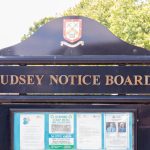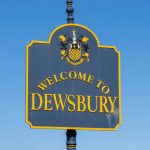Your five-minute guide to Bradford!
Did you know that Bradford invented school dinners? This English city was the first one in the UK to have funded meals for its children back in 1906. It was thanks to the success of the trial that the Provision of School Meals Act was rolled out to other schools. But as interesting as that fact is, Bradford has come a long way since the days of lumpy school lunches.
History of Bradford!
Bradford’s name is derived from two Old English words – “Brad”, meaning “Broad”, and “Ford”, which is the word we use to describe a river’s crossing point. Originally, Bradford was called “Broadford”, but it became Bradford when it was named after the river crossing of the Bradford Beck at Church Bank, near the site of Bradford Cathedral.
As for its history, well. Bradford began its life as a Saxon village. By the middle ages, the village had evolved into a small town of just three main streets, though the uprising against the Norman Conquest in 1070 did leave the area in a bit of a state of destruction. However, between the conquest and the following two hundred years, Bradford was able to rebuild itself and gain prominence in the wool industry with their trade. Wool has been the trade in Bradford since medieval times, with the wool being woven in the town and then sold in markets and traded. Wool was also dyed in Bradford.
The Manor of Bradford was held by De Lacy’s family until 1311. It wasn’t until 1620 that this manor was passed to a private owner. Bradford slowly grew more important throughout the 14th and 15th centuries, and in 1461, it was finally granted the right to hold two annual fairs. These fairs attracted traders and buyers from all over Yorkshire.
By 1500, a grammar school had been erected in Bradford. In the late 16th century, the wooden houses in the town were rebuilt in stone. The early 17th century was a time of suffering for the people of Bradford; the civil war came to the town, and there were several outbreaks of the plague.
The 19th century saw many changes for the town. Between 1800 and 1850, Bradford developed into a town that sprawled across the valley’s sides; the town centre expanded, old buildings were replaced with new ones, and Victorian architecture became prominent in the streets. That same style of architecture is visible in modern Bradford.
During that same time period, it was estimated that two-thirds of the country’s whole production of wool was processed in Bradford, alone. Bradford was the wool capital of the world, and a key financial centre for the industry.
There were other improvements to Bradford during the 19th century. In 1843, an infirmary was built. The first park opened in 1863. The first public library in Bradford opened in 1872, and the railway connected Bradford to the rest of the rail network in 1846.
Bradford was granted city status on the 9th of June 1897 and became a metropolitan district council in 1974. Although the wool industry and fellow textile-based industries have declined in the area, modern-day Bradford is much more diverse now; boasting a range of technology industries that help with the city’s innovation and the public’s skills. For example, some of the top industries in Bradford at the moment are engineering, media, and finance. In 2009, Bradford became a UNESCO city of film.
Bradford is a city that moved on with the times, instead of trying to hold on to an industry that doesn’t need thousands of workers per city to function in the 21st century.
What to do in Bradford!
There are many top attractions in Bradford that are great for all kinds of visitors. The National Science and Media Museum or the Bradford Industrial Museum are both great for anyone with a few hours to spare. While the Tong Garden Centre is a peaceful and beautiful place, which is great to visit during the spring and summer months. The rest of our guide is split into sections to help you find the best places for you to go during your visit to the city.
Shopping
The shopping scene in Bradford is a varied and pleasurable experience. The Broadway is their newest shopping centre, and its located right at the heart of the city. As is usual of a modern shopping centre, The Broadway is filled with brand names that you’ll have heard about in any other city in England. But that doesn’t make the building any less spectacular!
If you’re on the prowl for more independent shops to browse in, then it would be better for you to make your way over to the North Parade or even to Oastler Shopping Centre, which can be found on John Street. Oastler is a market that is popular for its amazing range of food from all over the world.
Kirkgate Centre is similar to The Broadway, with a lot of established businesses and companies calling this building their home; including shops like Primark. Other high street brands can be found in the Forster Square Shopping Park, right next to the nearby Forster Square railway station.
For boutiques and vintage or retro shops, Saltaire is the place for you. This location has regular markets and is in a great location for the delightful Victoria Road’s shops.
Food and Drink
Bingley Road has a variety of cafés and restaurants that are perfect for any visitor to the Bradford area. The Terrace Café, Bar & Bistro is a favourite among locals and tourists, alike! It’s a French restaurant in the heart of Saltaire, with a well-received reputation for amazing cuisine and even better hospitality.
Bradford is also known for its abundance of Asian restaurants and shops. There are over 200 Asian restaurants in Bradford, serving a range of food. Several restaurants specialise in curries that are inspired by traditional dishes from India, Kashmir, and Pakistan. In the city, itself, some of the more favoured curry restaurants include Karachi, Sweet Centre, and Kashmir. Karachi is the most interesting because it’s an informal restaurant with a BYOB rule.
The city is also home to many breweries, making a pub visit the best thing to do if you have a lazy afternoon to spare. Some of the most popular pubs are located in the countryside of the district, to name a few: The Flying Duck in Ilkley, The Woolpack in Esholt, and Haworth Old Hall.
If you’re genuinely stuck for an idea, have a look at Visit Bradford’s Taste of Bradford Trail for a list of other great recommendations.
Music and Entertainment
Bradford isn’t a major city, and as such, there aren’t too many music venues. With it being so close to Leeds, most people will go out of the city to find entertainment; but that doesn’t mean there’s nothing to do in Bradford.
The Underground is a live music venue in Bradford that exists on Duke Street. It doesn’t close until 2 am at night, and often hosts great bands that are formed by local people. Many music lovers enjoy going here for the great service, as well as the diverse music.
There is also Burnel Rooms, which regularly hold great nights for anyone looking to go out somewhere new. Guests have said that their drinks are well priced and taste great, too! There are even a few niche drinks that you might not easily find elsewhere.
But if music and alcohol aren’t for you, then you’ll be happy to know that the art scene does spread to Bradford. In fact, it’s flourishing there. From energetic theatres to the Bradford & Ilkley Literature Festivals, you’ll be able to find something amazing that will make you want to return again for another visit. Bradford Festival brings a vibrant and multicultural programme into Bradford’s own City Park; which is an area that has won multiple awards. It’s all about the time of year you visit if you’re after a special or unique experience in this city.
Travelling in Bradford!
The closest airport for Bradford is technically between Bradford and Leeds. The Leeds Bradford Airport is seven miles outside of Bradford, but it is a recognised regional airport; and one of the fastest-growing in the UK. If you aren’t travelling by air, you’ll be happy to know that the M606 will bring you within 1.5 miles of the city centre, and its links with the M1, the A1, and the M6. Bradford is also served by the National Express.
There are two main bus services in Bradford: First Group buses and Keighley & District Travel buses. The latter of the two offers services within the Keighley area, while First bus operates all over Bradford. A day pass on a First bus is just £4.70 for an adult; though it’s £4.60 if you buy your ticket using First Group’s mobile app.
Bus travel is the best way for students, in particular, to get around in Bradford. The number 576 bus runs from the city centre to the University and Bradford College every 10 minutes during the week. But if you aren’t a student, you’ll still be able to get where you want to go with any of Bradford’s 17 bus routes!
For a different way to travel between Keighley and Haworth, the Keighley & Worth Valley Railway links both locations via steam trains.
Places to stay in Bradford!
It seems most sensible to start this section off by highlighting The Bradford Hotel. This hotel is extremely close to public transport, offers free breakfast, and is a 4-star hotel that guests agree has good services. Its décor is modern, and nothing unexpected. It’s a hotel that looks like a hotel; it’s clean, has good colour coordination, and it has a great view. You can expect to pay around £35 to £45 a night for a room here.
Moving on to a more well-known hotel chain: Holiday Inn Express. This one is located firmly in Bradford City Centre and is currently sitting at 4.1 stars on Google Review. Over 600 guests have stayed here and left a review for anyone who might try the same accommodation. The décor is similar to The Bradford Hotel, but it’s a little cheaper; coming out at an average of £30 a night. Again, free breakfast is included in your stay, and the hotel is near public transport.
Last on our list of three is The Great Victoria Hotel. This hotel has a grill, a bar, and conference facilities. But despite being more expensive than the other two hotels we’ve listed, it should still only run you approximately £50 a night. The Great Victoria Hotel is a former railway hotel, so there’s some history there too.
As for Air BnBs, visitors would be looking at around £30 to £70 a night and have the option to stay in a range of available places; including flats, rooms, houses, and even penthouses!


